Album of the Week
Editor's note, March 17, 2010: The idea for the Album of the Week came up in a roundabout fashion. I wanted to write reviews of my albums, but to write about them all seemed too much. I tried a Top 10 and a Top 25 before realizing that there was no way that I could cut anything from the list of 52 that I wound up with. Hence, one a week, and as is evident from this page, I was three albums short when my inspiration ran out. The biggest challenge is writing something enthusiastic about an album that you have cared for a lot, but have grown tired of in the ensuing years.
The Album of the Week
(None, since the last update.)
Past Albums of the Week
Albums are archived here roughly in the order in which they qualified to be included on this page.
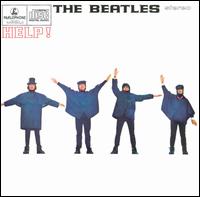
The Beatles: Help! (1965) – Help! is the defining music of my childhood. I cannot recall there was ever a time when I did not know those songs like second nature. Swedish national TV showed the movie as a tribute to John Lennon in late 1980 or early 1981 and I don't know how many times I watched it.
Of the overlooked and/or underrated albums in the Beatles discography, this album is in my opinion the one that deserves it the least. It could quite possibly be Golden Age Syndrome talking here, but still I feel that Help! should garner more attention. The album has a bit of the Beatles for Sale world-weariness, but also some uptempo songs that truly show the essence of sixties pop at its best. On here, we see for the first time the influences that within mere months (Rubber Soul) would take the Beatles from the safe pop path and into more experimental territory.
Spotlight song: You've got to Hide Your Love Away – the Dylan influence might be overt, but this song is still a work of genius and easily one of John Lennon's best.
Thanks to: Dad.
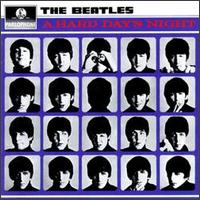
The Beatles: A Hard Day's Night (1964) – This is sixties pop music at its very best, and still as fresh in 2006 as it was in 1964. A Hard Day's Night is unabashed fun, easily the Fab Four's most positive and outgoing album. This is half an hour of sheer pleasure. It might not reach the creative heights as their later masterpieces, but for someone who's into sixties pop music, more specifically the Mersey Beat, it is a must.
It is unfortunately rather easy to take The Beatles for granted nowadays and underestimate just how fresh and creative they were in the sixties. Who else in 1964 had the courage to issue one 13-track LP containing all-original and new material, no single and no filler, and come to think of it: who else had the skill?
Spotlight song: I'll Be Back – one of the Beatles unknown tracks that deserves a mention.
Thanks to: Dad.
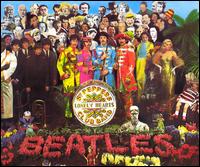
The Beatles: Sergeant Pepper's Lonely Hearts Club Band (1967) – No record collection is complete without a copy of Sgt. Pepper. So much stuff has been said about this album already, entire TV shows have been devoted to it, it's been revered, parodied, who knows what else. Some critics call it the first concept album, Mike Portnoy of Dream Theater say it's where progressive rock started. What could I possibly say about Sgt. Pepper that no one's said before?
Well, my opinion, for starters. It is not easy listening, like the poppier and more easy-going mid-sixties albums. Pepper is a logical continuation of the stylistic road that the Beatles started going down on Rubber Soul and continued on Revolver. Fed up with endless tours and frustrated at not being able to hear themselves play—and when they did hear, they thought they sucked—this album is where the Beatles for the first time said, the album is our performance
.
And what a performance! The level of detail, the love and skill with which they've crafted the arrangements on these songs are absolutely breathtaking. At a second glance, no one has ever bought the idea that Sgt. Pepper is a concept album; the concept as it is petering out about halfway through the second song and then resurfacing briefly in the penultimate number, but somehow it still works. It's a concept album because they said it was, and it just doesn't let up. I can always tell that an album is good when there is no logical point to press Stop until the last track is finished.
Spotlight song: A Day in the Life
Thanks to: Dad.
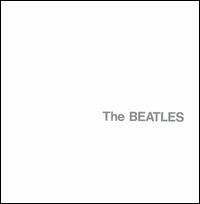
The Beatles: The Beatles (1968) – There is a weird cosmic symmetry evident when I compare my musical coming-of-age to that of my father. The Beatles released Yesterday and my dad and his friends started listening to the Rolling Stones, since you can't listen to music that the old man likes
. When Metallica released Nothing Else Matters, my friends and I ditched them in favor of Slayer and Sepultura, since if my parents went to a Metallica concert, we had to find something else.
In 1968, my grandmother came home with a Beatles album with an all-white sleeve. Eponymous, it is nowadays referred to as the White Album. In 1992, my mother bought Metallica's eponymous fifth album, commonly referred to as the Black Album.
The White Album might be full of whimsical (Glass Onion), funny (Piggies) and tender (Good Night) moments, but I always think of it as a pretty hard-edged album—Helter Skelter, Yer Blues and Happiness is a Warm Gun. It's got some of both Lennon's and McCartney's finest writing as well as an emerging master songwriter in the post-sitar George Harrison.
There are those who say that the Beatles should have consolidated their wealth of musical material into one very good single album. I always agreed, citing stuff like the throwaway Wild Honey Pie or the incomprehensible Revolution 9 (which to this day, not even after falling for Ligeti's music, is utterly bewildering). However, when I tried to fit the songs I liked from the White Album onto a single 80-min CD-R for some nice travel music, it wouldn't fit. Let alone a 45-minute LP!
Spotlight song: Blackbird
Thanks to: Dad. And Grandma.
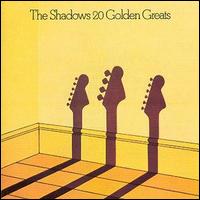
The Shadows: 20 Golden Greats (Collection, 1977) – Hank B. Marvin & co came along at a vital turning point in my life. I had got into their music a little bit and was a little unsure about what to do and where to go. Then I heard myself sing for the first time, which promptly made me decide to dedicate my talents to instrumental music. At least, I would do my very best to improve my lead guitar playing, and these 20 songs turned out to be quite the challenge to master for a 13-year-old.
My propensity for playing Shadows tunes from time to time had some hilarious consequences. Before we got our act together and got down to playing metal, Linus and I used to jam on some of these instrumentals. Once, a guy came into our rehearsal pad as we were playing Foot Tapper. The poor guy almost had a heart attack on the spot when he saw that it was being played—not by people his age but two teenaged kids. We had a long conversation about music while he recuperated and then he ended up giving me a cassette so that I could make him a copy.
What was the verdict? "Good music when you're doing dishes." I just hope I never wind up in a situation where I need to pass such judgement on the music of my youth...
The 20 Golden Greats is a wonderful collection and the best part is that it only goes up to 1967, when they still played original compositions that were fresh and new. After that, they turned into a bit of Richard Clayderman with Fender Stratocasters, making sappy instrumental versions of contemporary hits. Hank's Stratocaster or not, I think I still prefer the originals.
It should, however, be noted that I do not own this very album myself. I own a recent remaster, expanded onto 2 CD:s and dubbed 50 Golden Greats. Several of these are the aforementioned cover tunes, but the original 20 are still to be found, and I wouldn't want to be without them.
Spotlight song: Atlantis – exquisite guitar playing by Hank B. on the greatest Shadows song.
Thanks to: Dad.
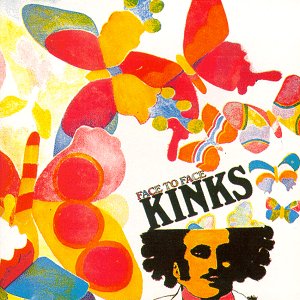
The Kinks: Face to Face (1966) – It seems that in my corner in the world, there are two kinds of people: those who worship the Kinks and those who have never heard of them. Maybe I am in a third category, for I don't necessarily worship Ray and the boys. However, I do think that of the early 60s bands, The Kinks are second only to the Fab Four themselves, and that is a high honor indeed in my book.
The Kinks have written and recorded hundreds of songs over the years, and not all of them are good. In fact, it is hard to find even one album that is excellent all the way through, like their colleagues from Liverpool managed to pull off, oh, about six times in a row. Face to Face is however a wonderful album, easily The Kinks' best, with Arthur a close second. On this disc, the boys play it rather straight: the observational, slightly satirical lyrics are prevalent, but the music is still straightforward 60s pop with an edge.
It is pleasing to note that The Kinks have managed to make an impression on the music business. Judging by their biography that I borrowed from my father, they always seemed to be on the cusp of something really great, and they did something really stupid and either got into a fight or made themselves impossible in some other dumb way. A four-year ban from performing in the States is not your obvious career move.
Spotlight song: Rainy Day in June
Thanks to: Dad.
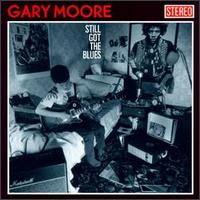
Gary Moore: Still Got the Blues (1990) – Gary Moore hit me like a ton of bricks in the spring of 1990. I had been playing Beatles and Shadows songs for quite some time and had just about worked myself into a rut, and I needed something new to pull me out of it. When I saw the video for Oh! Pretty Woman (no relation to the Orbison hit), it sparked a complete and utter reexamination of where I was and where I was going with my playing. Moore was just a hint of what was just beyond the horizon, but at the time I didn't know of anything else and I couldn't believe how anyone could play the guitar like that.
I have never been a big fan of blues music, but this is not the forum where I discuss my beef with that genre. Let's just say that as of yet, I have yet to understand what the big deal is, but I digress. On the other hand, I have no problem with infusing other musical genres with bluesy elements. And I can jam on bluesy-type stuff forever, but that's just because I'm a guitar player. In order for me to enjoy blues, you need to juice it up by adding a liberal amount of attitude from rock and roll or even metal. That's what Eric Clapton did (well, not metal, but rock anyway) before he turned all traditional and boring and that is what Gary Moore does on this classic album.
And as if his playing wasn't enough in itself, he has the most fantastic guitar tone in music, the proverbial silken Les Paul/Marshall sound to die for. You could listen to the album for any of these things: songs, guitar playing, guitar sound, and still have his great voice to marvel at.
Spotlight song: Still Got the Blues
Thanks to: MTV.

Metallica: Master of Puppets (1986) – There is this thing about metal fans, a sort of dichotomy between on the one hand the protectiveness towards your own private genre of music that few others have heard and on the other hand the desire to spread the gospel and bring as many people as possible into the fold.
Linus and I became good friends in eighth grade, around 1989 or so, and he wasted no time whatsoever in trying to convert me to thrash metal. The first album that I was played regularly was Master of Puppets, and sure enough, through the softer tones of Welcome Home (Sanitarium) and the instrumental Orion, my ears slowly adjusted to the harsher sound of James Hetfield's ESP Explorer instead of Hank B. Marvin's Stratocaster.
With Puppets, we are in the middle of Golden Age Metallica, four years of album-making that started with Ride the Lightning and ended with the masterpiece ...And Justice for All. This is the very essence of thrash metal and there is not one dull moment on this album, from the acoustic intro to Battery to the frenzied last verse of Damage, Inc..
R.I.P. Cliff Burton (1962-1986)
Spotlight song: Master of Puppets – it is ironic that Metallica's best guitar solo is played by the rhythm guitarist.
Thanks to: Linus, for the mix tape.

Metallica: ...And Justice for All (1988) – Justice is the Sgt. Pepper of thrash metal, a masterpiece that hadn't been equalled before and has not been bested since, especially not by Metallica. This is Metallica at the top of their game, taking the thrash metal that they invented, putting it through its paces and concocting 65 minutes of very hard and progressive metal music.
The most obvious aspect of this album, and what makes it this good, is that no one is holding back his talents. The songwriting team of Hetfield/Ulrich is not afraid of digressions, they pile up riff after riff until they've hammered the point home. Some say they went too far, I say that this is a work of genius.
Everyone plays well on this album. Lars Ulrich is at his best when the music moves too fast for him to actually think about what he plays, his random bass drum clicks and cymbal bombs actually propel the music forward. Kirk Hammett is in top form on Justice, alternating melodic sensibility with aggression (One); electrified blues on steroids (To Live is to Die) with plain old fun (The Shortest Straw).
Much has been said about the production values of Justice and I will also add my two cents to the pile. Personally, I think that the colder, drier, harsher sound not only fits the music, it is essential to the music. I couldn't imagine the fluffier, more ambient Puppets sound on this album, it would have taken the edge away from these songs. I could do almost anything just to play for ten minutes with James' rhythm tone on this album. The real shame is that in pumping up the guitar tone, the bass disappeared. I can hear a bit of bass on the title track, when the triple-time opening riff comes back after the solo, but that's only on a good day when my tinnitus isn't acting up on me.
Spotlight song: One – of course!
Thanks to: Linus, for persevering.

Yngwie Malmsteen: Marching Out (1985) – This was the very first metal album I ever purchased and I don't know if that simple fact is the only reason behind Marching Out qualifying for this list.
Yngwie Malmsteen's second album was more of a band effort than the first one, and it shows. This is in my opinion a successful marriage of Yngwie's particular brand of neo-classical shredding and good old Dungeons and Dragons heavy metal. In my opinion, this slightly theatrical variety of metal and Yngwie's playing fit each other like a glove, and sure enough: he immediately strayed from this path and did not issue an album of this stature until 1999's Alchemy.
Just as on Yngwie's debut, the technical sound quality might leave a bit to be desired, but there is no mistaking the energy and spirit permeating the entire recording. Lyrically, it might be puerile, but who listens to an Yngwie Malmsteen album for the lyrics anyway? You want to hear him play the guitar and that he does really well on Marching Out.
Spotlight song: Disciples of Hell
Thanks to: Myself, actually!
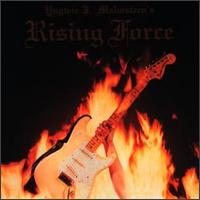
Yngwie Malmsteen: Rising Force (1984) – Even Malmsteen's detractors will grudgingly admit that this disc had a certain impact on how we guitar players approached our instruments. Joe Satriani has remarked that this album made his guitar students much more aware of theoretical issues such as modes and scales. It belongs far up on the list of influential guitar albums.
I was more familiar with Yngwie's later works when I got to know this album intimately, and from collecting much of his band stuff before he went solo, it is strikingly evident that the earlier recordings you can get, the better. Almost as if Yngwie's musical instincts started to erode the minute he arrived in L.A.
It has nothing to do with how fast he plays or anything like that; probably the man is twice as fleet-fingered today as he was in 1984. The thing is that if you don't put your soul behind every note, it doesn't matter if it's a 128th-note or four tied whole-notes. There are many guitar notes on Yngwie Malmsteen's debut album, and the thing that counts and that separates him from his many imitators is that he means each and every one of them.
That these are eight really good instrumental songs merely give the excellent playing more purpose.
Spotlight song: Far Beyond the Sun – easily Yngwie's best song and this version is also the pure, melodic version, unspoiled by later stage extravaganzas.
Thanks to: Myself!
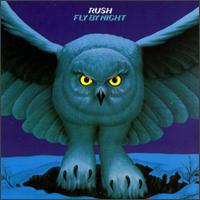
Rush: Fly by Night (1975) – Rush has almost always existed in the background for me, but I've only gotten into their music in the last couple of years. As they are not especially well known over here in Sweden (people tend to think you're talking about Jennifer Rush, which is decidedly not the case...), it took an amazing confluence of coincidences to make me acquainted with their music.
Again, my good friend Linus gets the credit for introducing me to a group. He played me Rush for the first time in 1990 or possibly 1991. I was immediately amazed by how a trio of musicians could sound so big. I was absolutely floored by the sheer brilliance of their musicianship and how their sound brought out the nuances in the music so perfectly.
It might be Golden Age Syndrome, where the first album you're exposed to is always more special than the others, but I think Fly by Night is undeservedly underrated. It stands head and shoulders above its immediate predecessor and successor and is right up there with Rush's very best efforts. Fly by Night positively vibrates with energy and creativity. It is so evident just how much Neil Peart added to Rush when he joined in 1974.
Spotlight song: By-Tor and the Snow Dog
Thanks to: Linus.
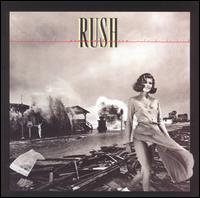
Rush: Permanent Waves (1980) – I think Alex Lifeson is an underrated guitar player mainly because he is a team player. You don't realize how difficult his parts are until you try to duplicate them yourself, and only belatedly do you realize how the influence of Lifeson and his Rush compatriots has been subsumed in your playing. Studying Rush's 70s albums is an instruction manual in how to make a power trio sound huge. There are all sorts of subtle litte lessons in ensemble playing and creating various textures by altering your attack, technique and carefully choosing between effects and where to put them. The most important thing I have learned from "Lerxst" is that hard rock does not necessarily need full-on distortion and power-chords all the time; most of the time, backing off on the fuzz and playing more colorful voicings provides the power and edge you need.
Permanent Waves was the second of two albums that Linus introduced me to in the beginning of the 90s. I have been listening to it off and on since then—for the last five years more on than off—and I have yet to get even remotely fed up with it. It is a perfect example of how you can combine progressive rock with the radio format without alienating either camp. The songs are short and to-the-point enough that the average listener isn't scared away, but there is so much detail and care in the structures, arrangements and individual performances that it is a constant reward to listen to. You always find something new to be amazed at.
This album stands at a critical junction in the career and development of Rush, a sort of crossroads between the progressive fare of their earlier albums and the radio-friendly, synthesizer-driven songs of their 80s output. On here and the follow-up Moving Pictures they struck gold—the perfect balance between the two styles: at the heart of it all, it's a hard rock band, but then they add additional layers of keyboards to vary textures and moods. It's just that it is always just enough: even in keyboard-dominated songs, they aren't overdone and they never dominate the way they do on subsequent releases.
Spotlight song: Jacob's Ladder
Thanks to: Linus
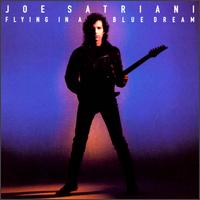
Joe Satriani: Flying in a Blue Dream (1990) – Joe Satriani is one of the finest guitar players in the world, and Flying in a Blue Dream is his magnum opus. Over the course of 18 songs, he runs through the entire gamut of moods and feelings as well as demonstrating almost every possible way in which you can play a guitar. Still, this album never once goes overboard, which is astounding if anything. What sets Satch apart from the also-rans in guitardom is that in spite of the mind-boggling fretboard mastery, he always means what he plays.
More importantly, the songs themselves are what counts and Satriani never lets his shredding get in the way of what he wants to say. And in sharp contrast to his friend, colleague and former student Steve Vai, Satch always keeps two feet firmly planted on the ground and his playing well within the familiar bounds of blues-based rock and roll. No one can write a rock and roll instrumental like Joe Satriani.
For most people, Surfing with the Alien is what comes to mind as the first association to the name of Satriani, but I think this is the superior album of the two. To those familiar with Surfing, there are a few familiar touches, such as the down-home driving rock of One Big Rush and Back to Shalla-Bal and the tapped chordal work on Day at the Beach. The main difference is that Satriani stepped up to the mike on this album and actually sings on a few numbers, most notably the heartfelt ballad I Believe. And, speaking of ballads, he also proves that he can tug at your heart-strings on the wonderful The Forgotten (part 2).
If you are in any way enthustiastic about rock and roll guitar, pick up this album and prepare to be very, very impressed.
Spotlight song: The Mystical Potato Head Groove Thing
Thanks to: Guitar World.

Steve Vai: Passion & Warfare (1990) – For some reason, Steve Vai and Joe Satriani are always mentioned in the same breath. Maybe it could be that both are Long Island Italian-Americans, fretboard wizards, Ibanez endorsees—and guitar gods. It is also noteworthy that these two gentlemen happened to release their best albums almost at the same time, and therefore it is unavoidable in the eyes of the present author that talking of one will lead one onto another. And discussing them by way of contrasting them is interesting in its own way.
However, that is a disservice to this absolutely splendid instrumental rock and roll album. If I am permitted to be quite honest, and on my own home page I think I can allow myself the luxury, one song alone is worth the purchase of this entire album: For the Love of God. It's the quintessential guitar ballad, performed by a player who is so totally in the zone that it's scary. Whoever says that someone cannot play fast and emotionally at the same time should take the time to listen to this song again. Legend has it that Vai nailed the lead part in this song in one take and that his fingers were bleeding afterwards. I don't believe many legends, but this doesn't sound that far-fetched.
Steve Vai's music isn't for the faint-hearted: at the heart it is the same brand of instrumental guitar rock that his former instructor Satriani does really well, but Vai adds his own frenzied, out-there attitude to the mix. When you add up all the little details: weird noises going on one channel, odd snippets of voice samplings on the other, it can be somewhat unsettling in headphones—c.f. The Riddle. Other moments are just plain fun (The Audience Is Listening) or stunningly intimate and beautiful (Sisters). It is a wild ride of an album that can stand being listened to over and over.
Spotlight song: For the Love of God
Thanks to: Myself

Slayer: Seasons in the Abyss (1990) – Slayer's output during the 80s was very varied and displayed just about one compositional style per album: punky proto-thrash (Show No Mercy), long multi-section songs (Hell Awaits), incredibly fast songs (Reign in Blood) and slower, more atmospheric numbers (South of Heaven). On this offering from 1990, Messrs. King, Hanneman, Araya and Lombardo combine all those styles into a unified whole, that together cancels out all the less palatable aspects of the earlier works.
Slayer isn't about melody or groove or even good lead guitar playing, but slamming you right in the face with tons of cool riffs, decorated by virtuoso drumming and Tom Araya's characteristic bellowing. Seasons in the Abyss doesn't disappoint in any of those areas and it even adds some of that which has previously been missing. Especially Kerry King has invested some effort in playing guitar solos that actually fit the key and where you can actually hear the individual notes.
But that's going into too much detail. Just put this on and let it assault your senses. You will find few better thrash metal albums by anyone.
Spotlight song: Dead Skin Mask
Thanks to: Linus.
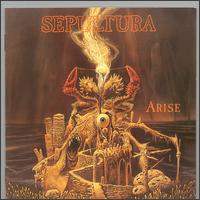
Sepultura: Arise (1991) – Sepultura were to us in 1991-92 what The Rolling Stones were for people in my parents' generation. In 1965, The Beatles released Yesterday. In 1991, Metallica released Nothing Else Matters. The situation was clear and totally unacceptable. Serious metal fans could not listen to music that their parents enjoyed. We decided that history could teach us something, took a page from our fathers' books and started listening to Sepultura instead.
Arise was the album that got me into growled death metal type vocals. I vividly remember the first time Linus played me the video for Dead Embryonic Cells, taped over Sunday night from MTV's Headbanger's Ball. I didn't like that growl at all, but I almost soiled my pants when Andreas Kisser cranked out that solo, and the mosh part on open E that follows (and the coolest staccato cymbal kill in music history!) was enough to sell me totally on Sepultura. It's just too sad that hearing the same riff played on Igor Cavalera's toms live in Lund has so totally anticlimactified that part for all subsequent listens.
This album, like so many others of its kind, grabs you from the get-go, but after the sixth song it kind of becomes too much of a good thing. What captivated the imagination of my friend Linus is the same thing that I would like to underline here and now, namely how the drum style of Igor Cavalera differs from that of other thrash or death metal drummers. It is expected to the point of cliché that Brazilians know a thing or two about rhythm, but this drummer incorporates his Brazilian heritage seamlessly into the standard bag of thrash metal tricks, and that's what separates Sepultura from most of their peers.
For my own part, I can think of few other albums where the production and the songs go so well hand-in-hand. Most importantly, the guitar and drum sound complement each other and the riffs perfectly. Then I have to tip my hat to lead guitarist Andreas Kisser, who by this point still had the perfect touch and knew when to let it rip and when to play something more moody and melodic. His later works were more about making noise, which might or might not fit the needs of those particular songs.
On the whole, this album is one of the essentials in thrash metal and would probably be high up on my personal Top 10 had I decided to post one.
Spotlight song: Subtraction – easily Kisser's best guitar solo and the part that follows is just... wow!
Thanks to: Linus, for knowing how to program a VCR.
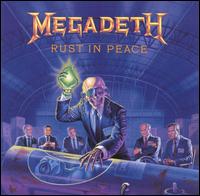
Megadeth: Rust in Peace (1990) – Rust in Peace is one of the best guitar albums ever made, period. Thrash metal as written and performed by Megadeth turned out to be the perfect outlet for the skills of Marty Friedman with his exotic scales and unorthodox phrasing. And as if that wasn't enough, Friedman turns out to be the perfect foil and counterpart to Dave Mustaine's more traditional and blues-based solos.
But in all honesty, this is putting it far too simply, if not unfairly. This album can't be boiled down to being just a guitar album. True, there is a lot of technical guitar playing and many long guitar solos, but it also features a very fine effort from the rhythm section as well as intricate and complex song crafting. I can listen to it on several levels, most of the time as a great guitar album, but sometimes also as a masterpiece of metal with progressive tendencies.
Unfortunately, Rust in Peace runs out of steam prematurely through the mysterious addition of the low-key Dawn Patrol. After this, the title track doesn't pack enough oomph to pick up the slack and bring the record to a satisfying conclusion. But since I think the album's emotional highpoint is on the seventh song, Tornado of Souls, I usually simply leave it at that and almost never listen to the last two tracks.
Spotlight song: Hangar 18
Thanks to: Myself.

Entombed: Clandestine (1991) – Some would hold up Left Hand Path as the seminal opus in Swedish death metal, but I beg to differ. Clandestine has no peer when it comes to sheer musical brutality. This album was religion to me during the better part of 1992 and about halfway through 1993. I lived and breathed this splendid album and listened to it at least once a day throughout that period. The only bad part with getting to know Entombed first among the many acts in Swedish death metal was that these guys set the standard and no one else were able to come close to delivering.
Clandestine doesn't mess around with weird intros, it cuts straight to the chase with nary a cymbal crash and for nine relentless songs, does not let up until the clean guitar intro to Through the Colonnades. Even though through-and-through this might not be music to everyone's taste, I have seldom heard such anger in music before or since, and taken together, this is truly something that should be in everyone's collection. If you are pissed, there is no more cathartic experience than Clandestine save perhaps primal scream therapy.
Spotlight song: Chaos Breed – summarizes Swedish death metal inside of five breathless minutes.
Thanks to: Linus.
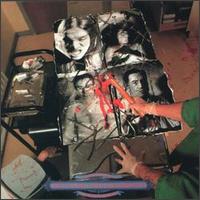
Carcass: Necroticism – Descanting the Insalubrious (1991) – After two questionable grindcore albums of little worth except possibly for campy humor, Carcass decided to get out in front and deliver ground-breaking death metal that is as melodic as it is abrasive and as bone-crushingly slow and heavy as hyper-fast at times.
Not only is the album a wonderful instruction in English medical vernacular, complete with spoken intros sampled from what appears to be autopsy instruction videos. It also features the finest guitar solos in death metal courtesy of Messrs. Bill Steer and Michael Amott. The guys even name their individual solos, using monikers befitting the general theme of human remains, stainless steel forceps and medical mishaps.
The next time, guys, we want the pictures to go along!
Or, to summarize this review in the declamatory style of Jeff Walker:
Whish!
Spotlight song: Incarnated Solvent Abuse – the heaviest riff in death metal, followed by two awesome leads.
Thanks to: Myself.
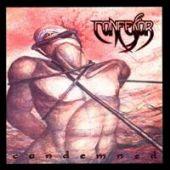
Confessor: Condemned (1991) – Confessor cannot be defined and have to be experienced to be believed, and when the first track on this album gets underway, even then it is not totally certain that you will believe it.
They toured with Entombed, Carcass and Cathedral but are so far away from them musically as to defy comprehension. About the only thing these four bands have in common is the extreme nature of their music. Confessor's might be close to the genre in structure and general sound, but not in its rhythmic complexity.
This is a drummer's wet dream, full of dazzling skinsmanship, odd meters, polyrhythms, off-beat accents that when they finally decide to start grooving in four fourths, you're thrown off the beat. The music is not so much about the riffs or melodies as the rhythms and general feeling. The singer, always wailing at the top of his rather high register, sounds like some random guy they sampled while singing in the shower next to the studio. The riffs are ultimately forgettable, but the unified whole definitely leaves an impression.
Spotlight song: Uncontrolled – let's listen to the three-armed drummer!
Thanks to: Linus.

Cathedral: Forest of Equilibrium (1991) – In the Forest of Equilibrium, English mists are woven among wooden statues, granite archways and... hamfisted drummers. A rather clumsy effort by the hired session drummer mars the otherwise brilliant debut album of British doom metal band Cathedral.
This was an album that I bought on the strength of an EP that turned out to be an evolution of the style heard here, and I had to spend many evenings trying to find the one thing to turn me onto it. There are not many happy moments in Cathedral's music, perhaps appropriate to their rather athmospheric band name, and the passages where they accelerate past glacier speed are few and far between.
Still, this is immensely enjoyable music for when you have the time and the patience. It moves slowly along, but it is perfect for those dark, late-autumn nights with, well, Linus and I had Coke and potato chips, obviously not your typical doom metal fans! Out of the four bands on the Gods of Grind tour, Cathedral is the act that grinds the least, but that does not make them less interesting, on the contrary.
Spotlight song: Equilibrium.
Thanks to: Myself.
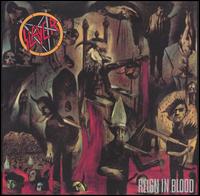
Slayer: Reign in Blood – This is brutality personified in music, one of the Top Three thrash metal albums ever. Listen to it. Short album = short review.
Spotlight song: Raining Blood
Thanks to: Linus.
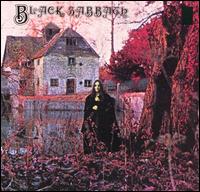
Black Sabbath: Black Sabbath (1970) – There is a raw power to Black Sabbath's debut album. Having never seen them live (Ozzy solo with Geezer on bass doesn't count), especially not in Birmingham back in the day, I can only speculate as to how they could have sounded, but judging from the fact that they recorded this album in no more than six hours, what wound up on disc cannot be that far from how people heard them in clubs.
There is a number of Black Sabbath classics already on this album, but I keep getting hung up on their ensemble playing as the enduring impression. There is a ton of stuff to learn if you study the interplay between drums, bass and guitar. Dynamics is one area. Just by holding back during the verses of the title track—clean guitar, subdued bass and the rumbling tom-toms—they are able to keep that awesome riff going for the better part of the song: two full rounds of riff + verse and yet another riff before the triple-time outro and solo. Just listen to how Geezer Butler plays his own little bass solo behind Tony Iommi's guitar solo on both Behind the Wall of Sleep and N.I.B..
Later Sabbath albums might be better in many ways including the production, but the rawness of this album never fails to have an impact on me. Then on top of this we have the fact that this was where heavy metal started. (Okay, Zeppelin fans, let me have it!)
Spotlight song: N.I.B.
Thanks to: Jacob Horvath.
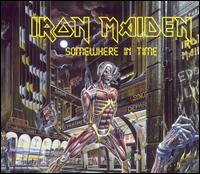
Iron Maiden: Somewhere in Time (1986) – Somewhere in Time is Iron Maiden at the height of their powers. Some might say that the later 80s albums are more experimental and less Maiden, but I think that this is everything that Iron Maiden should be. Well-written, intricate arrangements bordering on the progressive at times, superb individual performances that are brought together in a massive whole while never losing track of what one instrument is doing.
It is very difficult to write about this album, simply because what is there to say about a piece of music that is perfect? The music will have to speak for itself, I cannot add further to the discussion. Still, I would like to pinpoint some highlights of the album, first and foremost Nicko McBrain. The man is hands down one of the top 3 drummers in rock and metal, and I have still to figure out exactly how he does it. Just listen to how he plays on the title track: even fourths going on the ride cymbal throughout the song, but the music never slows down, it just keeps on pounding away. The man has the most amazing single bass-drum technique I have heard in real music.
Then it's the songs themselves, and here 'Arry and the guys have struck gold. Eight classic Maiden songs, possibly with the exception of Deja Vu, although that is admittedly a keeper as well. (With more McBrain magic, I might add.)
When I discuss the music with other Maiden fans, I frequently get raised eyebrows when I say that this and Seventh Son are their greatest works, just because they're more experimental. People who know me better have commented that it's odd that I should prefer these two when there are so many keyboards on them. Well, I have nothing against keyboards per se, it's just that they should never try to take over the role of the guitar. Then I have had nothing but sour experiences working with keyboard players, so I'm definitely anti-keyboards as long as my own projects are concerned.
Spotlight song: Caught Somewhere in Time
Thanks to: Linus, with Daniel Pettersen.
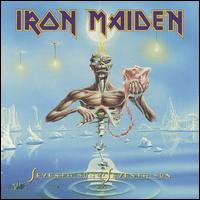
Iron Maiden: Seventh Son of a Seventh Son (1988) – I took a different route when getting into metal land, basically bypassing Iron Maiden. True, Linus played a lot of Powerslave and Somewhere in Time for me when his indoctrination started, and we listened a lot to No Prayer for the Dying when it came out in late 1990. I even undertook the adventure of going to Stockholm to see them in spite of not being 100% into them. It would take a lot longer for me to get into Iron Maiden.
When I got a little tired of thrash and death metal and wanted to explore more melodic territories, I discovered Seventh Son. It was a revelation for me. This album is one of Maiden's most experimental: a concept album with interconnected themes, recurring chord progressions and a bit more daring song structures. There is more conspicuous keyboard work on this album than on any other Maiden effort, but it is just subtle enough that it adds to rather than detracts from the songs.
Many parts of this album encapsulate what I think is metal at its best. Instead of pathetic posturing, screaming to the world how tough and uncompromising they are, Maiden simply let the songs speak for themselves. They are not afraid of piling up the riffs and digressing into musical territories that are far removed from the original idea, but it all sounds natural: every part is a logical continuation of the preceding part. And to top it all off, there's Nicko McBrain, Steve Harris and Bruce Dickinson in top form, coupled with Dave Murray and Adrian Smith at the height of their twin-guitar powers.
It is a complete mystery how a band like Iron Maiden could go from this masterpiece to the abysmal No Prayer inside of two years. But on the other hand, how could anyone write anything that's better? It simply had to go downward after this.
Spotlight song: The Clairvoyant – one of my favorite songs ever.
Thanks to: Linus and Daniel Pettersen.
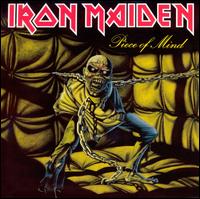
Iron Maiden: Piece of Mind (1983) – When discussing this early masterpiece of the classic Iron Maiden, one almost needs to think back to the time when it was first released: in the days of vinyl LP:s, when albums had a side A and side B. When I listen to Piece of Mind, I always put on the album from start to finish, but I only listen to the last five tracks. Or the B side, as it were.
I have nothing against the singles and live sing-along tracks such as Flight of Icarus, Die with Your Boots On or The Trooper, it's just that they've been done to death. It is all too easy to, as we say in Sweden, listen yourself deaf to those iconic songs, but if you do that, you run the risk of running yourself exhausted before you get to the real meat of this disc.
To be frank (ooh, the ironic pun!), the centerpiece of the second side (and in my opinion the entire album) is the Steve Harris epic that concludes it: To Tame A Land. This was neither the first nor the last in a long row of long, progressive, literarily or historically influenced Harris songs, but it sure is one of the freshest. As a devoted Dune as well as a Maiden fan, I think it's a damned shame that Frank Herbert disavowed any connection with Iron Maiden and wouldn't allow Steve Harris to use the name Dune for the song (nor would he allow a spoken intro a la Alexander the Great). His loss. But no matter what you call the song, it is one of the Maiden greats.
Spotlight song: To Tame A Land
Thanks to: Myself.

My Dying Bride: Turn Loose the Swans (1993) – The magazine is issue #2 from 1992—an extra section of Metal Hammer called "Thrash". On one of the last few pages was an interview with an English band called My Dying Bride, who had just released their album As the Flower Withers. I had been looking for doom metal that was more beautiful and depressing than Cathedral, and in the article, it sounded like MDB would do the trick: a violin player, lyrics in Latin, inspiration from classical stuff and Greek tragedies. The actual album had its interesting parts, but on the whole was no more than an athmospheric death metal album with some slow and some melodic parts. It wasn't really what I was looking for after all.
It wasn't until 1994, when I listened to and bought their then most recent album, Turn Loose the Swans, that I fell for the power of the music of My Dying Bride. In retrospect, they didn't find their style until this album, and the extraordinary thing is that so much changed in so short a time and just about everything to the better. Swans has that perfect balance of tempos, moods and emotions. The most vital difference from their debut album is that Aaron Stainthorpe alternates the death metal growl with clean baritone vocals, which fits the generally dark mood and slow tempos of the music, adding that extra touch of aggression only when the music requires it.
Turn Loose the Swans is second to none as an introduction to My Dying Bride, as it condenses basically everything about their style into six excellent songs (discounting the experimental last number). The best part is that they started out this good and then only got better.
Spotlight song: Your River – the essence of what My Dying Bride are all about, in one nine-minute song.
Thanks to: Myself, for finding something on my own for once...
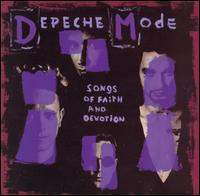
Depeche Mode: Songs of Faith and Devotion (1993) – I shouldn't listen to Depeche Mode. When I grew up, you were either a metal fan or a synth fan, never both. Well, I was a Beatles fan but that's just me. If you got into metal, there was an unwritten rule about synth music: it sucks. Depeche Mode do not suck however, but then again it is an open question about what one should really call their music.
As luck would have it, I got into Depeche Mode well after I ceased being a 100% metalhead. Indeed, I was very taken by both Anton Corbijn's video for Enjoy the Silence as well as the song in itself, but it wasn't until I heard Songs of Faith and Devotion that I realized just what geniuses these guys were. Superficially, I was drawn in by the prevailing dark mood, as well as the fact that DM by this time used not only distorted guitar but also real, acoustic drums.
However, that is belittling the music. This album is chock-full of haunting melodies, heartfelt songs and a generally dark mood. From the raw emotion and pounding rhythms of Walking in My Shoes via the gospel-tinged Condemnation, the devotional One Caress to the breathtaking crescendo of In Your Room, these guys leave none unaffected.
Spotlight song: Walking in My Shoes
Thanks to: Linus et al.
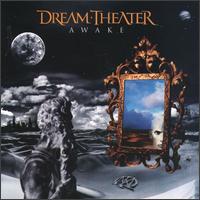
Dream Theater: Awake (1994) – Awake stands head and shoulders above its immediate predecessor and successor, but it was also almost the 'album that never was' for me personally. The first time, it was simply at the wrong point in time. I was more into classical music and whereas I dug the album from start to finish, I still preferred Shostakovich's string quartets, thank you very much. When I got out of that, this album was one of the first ones I bought, but after that, Metropolis came out and totally dominated the DT universe as far as I was concerned.
In one sense, I can see why many DT fans consider this their greatest. It does appear to have some elements that later works lack. Their more recent stuff is very much heavy metal with the occasional foray into other fare. On Awake, Dream Theater manage to integrate their various influences in a much smoother and more organic-sounding way. The earlier songs fit together in a less sectional and more natural way. In 1994, they were more of a band, nowadays they are more individual virtuosos that play together. I simply prefer the newer stuff because I like that guitar-heavy style more, I love hearing excellent musicians perform, especially when they mean what they're playing.
There is much variety on Awake: everything from the super-heavy seven-string-dominated The Mirror to the lyrical Lifting Shadows off a Dream, from the 20-minute tripartite suite A Mind Beside Itself to the concluding dark and gloomy ballad Space-Dye Vest. I especially like the sense of unity to the album as a whole: themes and snippets are quoted in other songs without for one moment sounding contrived. The Mirror flows seamlessly into Lie without stopping for a breath, and the solo section of the latter borrows the main riff of the former.
Spotlight song: Space-Dye Vest
Thanks to: Andreas.
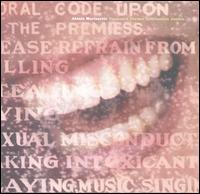
Alanis Morissette: Supposed Former Infatuation Junkie (1998) – I have a weakness for women, and not just in the sense of the fairer sex, but also female singer-songwriters. One of the most influential in my musical world is Alanis, whose music I got into in 1996 or so, when the Jagged Little Pill singles were spinning a lot on Swedish radio. A few years later saw the release of Junkie, which is less about the singles and is much more about fine music to be savored without any other distractions.
Junkie contains 17 songs. That thing in itself is worthy of note, since few artists manage to create such sprawling album song lists without at least a third of it having been added as filler. Very little on this album is filler, ironically the two songs that venture closest to such territories are the two songs that were selected as singles. I have some issues with the song order, more particularly that the two concluding tracks come across as a bit of an afterthought after the emotional highpoint of the album, the splendid Joining You.
The material is amazingly varied in arrangement, feel and style. Most of it is really good. Several songs are outstanding; emotional outpourings where few people in music can match Alanis' intensity. I personally prefer the unplugged I Was Hoping over the more electronic studio version, but that's me. Some of the songs just beg to be arranged in a heavy-metal setting, which incidentally confused the hell out of some people that I played with a couple of years ago. Others are so intimate and personal that you feel almost like a voyeur, like you've accidentally snuck a peek in someone's diary.
It is a sign of the times that this the most personal and interesting of Alanis' albums was a sales catastrophe by the standards that she set with her exceptionally popular debut. Junkie definitely deserves a spot in most people's record collections, but the music business being what it is, namely more business than music, it didn't move enough units and that was that. It is a pity that Alanis hasn't been able to get back in the zone on her three latest releases. She is not pissed enough anymore to write another Pill and she has probably been yelled at enough over the present album that the new stuff is... twilight. Too safe, too comfortable.
Spotlight song: Can't Not, Unsent and Joining You—three-way tie. Nothing on any other Alanis album is on this amazing level.
Thanks to: The Spirit of Radio.
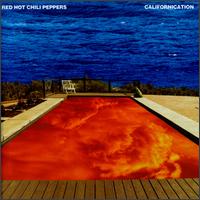
Red Hot Chili Peppers: Californication (1999) – I got to know the Chili Peppers gradually during the course of the 90s. At first, I hated Give It Away and erected mental blocks so as to keep myself from enjoying any of their other songs. Then I grew up and realized that they were actually doing something very interesting.
Then, Californication was released, and I was immediately hooked! What appealed to me from the get-go was that they had toned down much of what I did not necessarily care for on Blood Sugar Sex Magik, for instance the yelling/rapping. Instead, many songs are melodic, a little laid back and much more interesting in the vocal sense. I cannot deny that most of the singles from Californication have started to wear out their welcome in the many years that have passed since, but I never tire of hearing the title track and the upbeat Easily that follows it.
On this album, the Peppers were well on the way to something really great. It would only take us three years to get there.
Spotlight song: Californication
Thanks to: Andreas.
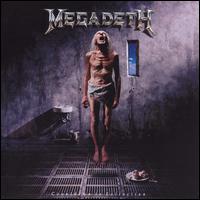
Megadeth: Countdown to Extinction (1992) – In spite of being released no more than a few months after I got into Rust in Peace, this album belongs to a completely different musical continuity as far as I am concerned. I never liked this album when it came out; it was only in 1999 that I got around to buying it and giving it the chance it deserves.
Just like Testament's The Ritual, released in the same year, Countdown could be seen as an answer to Metallica's self-titled black album, possibly even a sort of half-hearted attempt to jump on the bandwagon. It has many common features: more and shorter songs that are more concise and to-the-point, containing few or no musical digressions. In addition to this, Megadeth's album is also very dry. There is little reverb and ambience and the playing is tight to the point of being almost machine-like and rigid at times. What Megadeth have going for them is a slightly quirkier mode of songwriting. Compared to Metallica, they also have the advantage that Marty Friedman can actually make a pentatonic blues scale sound fresh and Nick Menza can make the simplest drum beat swing.
There are quite a few highpoints on this album, primarily the melancholy title track with its concluding twin guitar solo. I also very much enjoy the unusual Captive Honor, and of course no Megadeth album would be complete without a rocker or two: Skin o' My Teeth and High Speed Dirt.
Spotlight song: Countdown to Extinction
Thanks to: Myself.
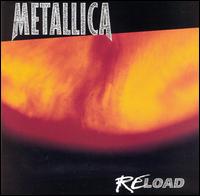
Metallica: Reload (1997) – To tell the truth, I had been rather bored by Load in 1996, actually to the point where I couldn't find the interest in me to listen to Reload at all when it came out. But that had its reason, if nothing else then an utter disillusionment with what Metallica stood for in my life (our lives). When I came back to the world of metal in 1999, I had some catching-up to do, and with the added maturity that a couple of years of enforced absence gave me, I was in a totally different position to accept this album for what it is.
It is no use trying to listen to this album as a Metallica album, especially not if your musical virginity was taken by Master of Puppets and ...And Justice for All. However, I do think that if you ignore the logo that is emblazoned upon the sleeve, or simply think of this as an experiment, it works much better.
The Load albums are enjoyable in their own way, but I don't listen to them when I want to hear amazing solos, dexterous drumming or a creative and driving bass player. Kirk Hammett gets few spots on which to show us his immense guitar knowledge and where he does get his time in the sun, he bungles the job and opts for tired blues riffing instead of the rare, tasteful combination of melody and aggression that so influenced me when I was younger. As per standard 90s Metallica M.O., Jason is hardly to be heard at all, and Lars Ulrich tries so hard to groove that he forgets that he is a thrash metal drummer who is at his best when the music doesn't give him time to think before striking the skins.
No, it's good old "Jaymz" who shines here. James Hetfield owns both this album and its similarly named predecessor; his efforts inspire me to come back to this album and listen to it again and again. He does so not just because he is a masterful songwriter and the best all-around metal guitar player, but because he is simply one of the best vocalists in metal and on this album he has truly found his voice.
Spotlight song: Carpe Diem Baby
Thanks to: Andreas.

Yngwie Malmsteen: Alchemy (1999) – Legend has it that Yngwie Malmsteen at some point during the nineties asked his fans what they wanted his next album to be like. The response was almost unanimous: more heavy stuff, like you used to! Yngwie followed suit: 1999's Alchemy is a true return to form, to the good old Yngwie of the early eighties, before commercial interests sucked the personality out of his music.
Alchemy embodies everything that is good about Yngwie Malmsteen without tacking on too much of what we tend to not like about the man. There are lots of cool riffs, long and sometimes interesting solos and the energy level is generally high. There is even a Gregorian chant in the intro to Leonardo and the last part of the concluding instrumental has no guitar. (Who are you and what have you done to Yngwie?)
The only song that doesn't work is the blues instrumental Blue, where Yngwie overplays to the degree where even a guitar aficionado like myself has to skip to the next track. Too many notes, my dear Malmsteen. Other than that, this is a really good heavy metal album that fans of the genre shouldn't overlook just because of Yngwie's name on the cover.
Spotlight song: Leonardo
Thanks to: Yngwie, for listening to his fans.
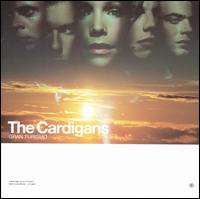
The Cardigans: Gran Turismo (1998) – In the middle of the 90s, I had not imagined that I would ever become a Cardigans fan. Their music was always a little too cute and poppy for my taste, I never felt the desire to listen to their entire albums. With Gran Turismo, all that changed.
This record does not venture too far from that territory, but still there's something intangible to it, maybe it's just enough attitude and edge that makes it stand out. I bought it on the strength of the two singles that were played extensively on Swedish radio in 1998 and '99: Erase/Rewind and My Favorite Game. I fell for those songs and Nina Persson's soft, silky, dreamy voice straight away and still have difficulty suppressing a silly smile whenever I happen to hear one of them.
It might not always be evident, but Black Sabbath was a major influence on The Cardigans. I can surely relate to that, and maybe what I like about the album is that little tiny sliver of Sabbath inbetween the electronic distortion and weird guitar tones. And maybe is that so many of the songs just beg to be arranged by a metal quartet.
Spotlight song: Do You Believe
Thanks to: Radio (for once).
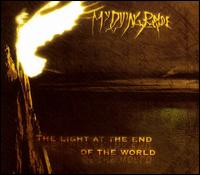
My Dying Bride: The Light at the End of the World (1999) – I have very strong memories of the fall of 1999: having my first very own apartment, forming Nox with Andreas and having the guys over to listen to the three new free one-minute samples of songs from My Dying Bride's new album The Light at the End of the World. After no more than 60 seconds from She Is the Dark, I knew that the Bride was back and that this was going to be one special album and that your humble narrator was going to be forced to go to the record store again.
My Dying Bride had been experimenting for quite some time: clean vocals only for the last three albums, no violin on the last one, 34,788 [etc] being almost entirely experimental through-and-through. On this album, it feels like they came back, only that they took the best parts of what they learned during their experimental sojourn and added them to their core sound.
I guess that the main reason why I am so fascinated by this album is that due to the lack of a full-time keyboard player as well as a second guitarist, it's very guitar-heavy with the additional interesting qualifier being that one guy plays all the guitar parts: Andrew Craighan. The early MDB might be borne up by Martin Powell's violin, but latter-day MDB is designed to work with guitar only and as a result it simply feels more at home for me. In this case, there is a lot of gonzo guitar stuff on this album, nothing flashy, just a ton of bone-shatteringly good riffs and insanely beautiful melodies. I can just imagine how much fun the guy must have had while dishing out all that playing in the studio.
If anything, this album is too much of a good thing. There is not a bad song on the disc, but still, every single time I play it I feel like skipping tracks 7 and 8 and go straight for the finale. Which is an emotional climax if anything: Sear Me III—as the title implies it is the third version of the original song off their debut album. Even the original was good. Then they made a MCMXCIII version with violin and piano that just floored me, and to judge by the quality of this third version, I sure hope that a IV is not in the offing. I'm just afraid that something might burst, somewhere.
All in all, this is a joyous, cathartic set of nine wonderful songs that range from the most tender and melodic to the hardest, most abrasive. If I wasn't allowed an Album of the Week, but just Nick's Top Ten, this would be in it.
Spotlight song: The Light at the End of the World – if you don't have patience for a ten-minute song, maybe you can take twenty minutes and read Aaron's poem?
Thanks to: My Dying Bride, for being back and also for allowing us to download the samples from their website.
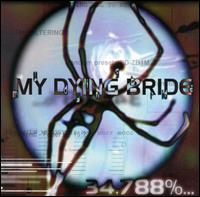
My Dying Bride: 34,788%... Complete (1998) – My Dying Bride and I had a little bit of a falling out in 1996 or so. It wasn't more complicated than that I was more into classical music and with Like Gods of the Sun they released an album that wasn't brilliant but merely very good. And when 34,788%... Complete hit the shelves two years later, it felt like the flame that had flickered on the previous album had gone out completely and they hit experimentation mode.
Now, I freely admit that I had my head up my arse and didn't even bother to actually listen to this album before I decided not to get it. Perhaps it would have been a moot point at the time, perhaps it required for me to get back into metal 100% in order to appreciate it fully. But even when just browsing the packaging and sleeve for 34, it felt weird and so totally un-MDB.
Which opinion didn't survive the first listening. From almost the first moment, I was blown away by this album. It was different, but still unmistakably MDB! The emotions were still there, it was just that they were different emotions. Instead of lit candles in velvet-clad chambers, we were presented with music that was more flickering tungsten lights over cracked concrete and derelict brownstones.
I never thought I would ever get to hear Aaron sing "na na na yeah yeah yeah" in this age of the world, but like most other things on this album, it is done with such utter and complete conviction that it doesn't sound out of place at all. They even throw in a drum machine here and there without having it sound anything else than 100% My Dying Bride.
Spotlight song: Der Uberlebende – If the world were fair, this could easily have been a hit song.
Thanks to: Myself, for letting the music speak for itself.

Tori Amos: Boys to Pele (1996) – It was probably a very strange experience for Linus when he played this Tori Amos CD for me way back in 2000. As I hadn't (and still haven't) gotten into Kate Bush's music, he likely expected me to have great difficulties with this as well. Well, I hadn't. There was just something about Tori Amos that made me go out and get this album straight away. And before long I had all of her albums.
It is no secret that I am childishly excited by long songs, but it has also been observed in this column that I am also very intrigued by albums that have a great number of songs on them. Maybe it's just a subconscious manifestation of my inner cheapskate: more songs for the money. But in reality, I think the answer is decidedly musical. One does not cram an entire album with 18 songs of the same kind and with the same sound. (Well, Tori does nowadays, but that's a different discussion.) The more songs, the more one can go off on tangents and explore alternative song structures and arrangements.
I was mostly taken by how Tori had made an album that was centered around her keyboard in the same way that I would like to do something around my acoustic guitar. It was so different from what I was used to listening to, almost chamber music-like in its general intimacy. And coming from a classical bout as I did, I was also very impressed by her mastery of the piano, which comes as an exhilarating change from the usual cling-clang piano butchery in pop music.
Spotlight song: Horses
Thanks to: Linus.
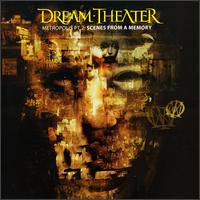
Dream Theater: Metropolis Pt. 2: Scenes from a Memory (1999) – I liked Dream Theater for a long time before I heard Scenes, but they had always been a bit of the wrong band at the wrong time. Images and Words came out at a time when I was a bit anti-technical stuff, preferring a heavy right hand and grinding riffs. When my friend Andreas played Awake for me, I was very much into classical music and it didn't hit home the way it perhaps should have.
Scenes was the album that in my mind transformed Dream Theater from a pretty listenable modern progressive rock band into one of my very favorite bands. I think that it was at this time that they left some of the more questionable fusion and soft ballad stuff behind and became more metal. But as soon as I've said that, I realize that this album is full of tender moments, and there is even a gospel-type ballad that is the emotional climax of the work. It simply felt more honest, less polished and also structured in a way that felt more logical and easy to get into.
I cannot underestimate the influence that this album has had on my writing and guitar playing. The accompanying live DVD came at an opportune moment, weeks before the recording of our second demo and sent me woodshedding for over two weeks, at least three hours per night (which is a lot in my book). John Petrucci is one of the top three guitar players and he truly shines on Scenes. Hell, everyone shines on this album! Even vocalist James LaBrie has learned a bit about register and isn't constantly screaming his balls off to reach those high notes, his voice is more a part of the music which works to the benefit of everything.
This is a must for people who are into progressive music, or metal, or both.
Spotlight song: Beyond This Life – "We're not machines." – J. Rudess.
Thanks to: Andreas
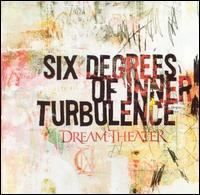
Dream Theater: Six Degrees of Inner Turbulence (2002) – After the progressive rock and metal of their first three albums, Dream Theater were heavily pressured by their label to produce an album that was commercially viable. That gave us Falling into Infinity from 1997, an album that is not particularly memorable, nor did it give them the windfall the label had expected. So, they basically had their way on the next record, which was for the better of just about everyone but the record company: Metropolis. So: commercial offering—check. Concept album—check. And now: double album—check.
Perhaps I should not speak of this work in such glib terms. Six Degrees is a monumental effort that takes up the torch where Metropolis left off and carries it one step (and one disc!) further. I have always held that what makes Dream Theater different from all the other bands of this kind is that their songs are head and shoulders above the rest. So is the case also on this album. It opens in chugging seven-string fashion with The Glass Prison, but those fourteen minutes are just the warmup. The heart and soul of this album is in my opinion not the otherwise brilliant title track on disc 2, but the second and third tracks on the first disc: Blind Faith and Misunderstood. Now that's scary playing! And fantastic songs!
The second disc is one massive 42-minute song where the individual parts fit with each other and the overture well enough, but you never get the impression that this is more than just a suite of individual songs strung together. Even the band acknowledges this and has split the song into its component tracks on the disc itself. I personally find the juxtaposition of moods going from The Test that Stumped Them All via Goodnight Kiss to Solitary Shell as exciting, exhilarating and engrossing every single time I hear the album. Even though the subject matter is rather tragic, one cannot help but break out into a big smile when the latter song comes on.
The subsequent revelation that Solitary Shell is no more than the bastard child of Solsbury Hill by Peter Gabriel and And You and I by Yes has perhaps knocked DT's halo slightly askew, but if you have to steal, do a good job of it and the boys really deliver on this one.
Spotlight song: Misunderstood
Thanks to: Myself.
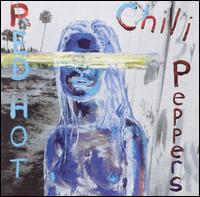
Red Hot Chili Peppers: By the Way (2002) – By the Way has few things in common with the early-90s Chili Peppers, and I love it. It takes up the torch where Californication left off three years earlier and goes even further into pop territory. Add a little dash of Motown here, some Latin grooves there and you get a very individual sound.
I can talk all night about how much I enjoy listening to John Frusciante, and this album is really his finest hour. A solo like that on Minor Thing, he proves that less doesn't necessarily have to be less. It is only a few notes, but he hangs on them and plays the shit out of them that you just sit silently by and stare in amazement at the speakers. The entire album is full with subtle guitar stuff: little overdubs and fills here and there, mostly sparse textures, which only serves to reinforce the times when three or four guitars enter for a crashing crescendo. He isn't even shy about getting his picking hand dirty on the neck for some uncharacteristic two-hand tapping for yet another textural effect.
Another thing that I usually don't notice about albums but which is here in abundance is vocal harmonies. Instead of John's usual falsetto background vocals and the odd thought-that-counts lead by Flea, many songs feature full three-part harmony, most markedly on Dosed, the climax of which is one of the high points on the album.
Spotlight song: Minor Thing
Thanks to: Andreas
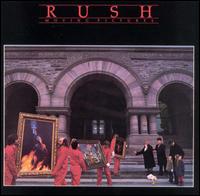
Rush: Moving Pictures (1981) – As a major Rush fan, especially one who thinks that Permanent Waves is their greatest album, I consider myself blessed that Rush had one more such album in them when they were at the peak of their craft. Moving Pictures begins where the previous album left off, in the same basic style of stripped-down, slightly more radio-friendly progressive rock that makes no compromises in the musicianship department.
As already mentioned, Permanent Waves is the better album by a whisker, but this one does contain what I think is Rush's finest song: Red Barchetta. I have seldom heard a piece of music that has such perfect synthesis between lyrical and musical content. The pure joy of fast driving is superbly captured in the arrangement of this song, especially on part of the drums courtesy of Professor Peart. And I've also read that he nailed it on the first take, the bastard.
Indeed, most of the album is about masterful songcraft coupled with instrumentation that is straightforward and hard-hitting where it needs to be and atmospheric and grand where circumstances require it. YYZ is a rhythm section extravaganza, followed by the melodic and moving Limelight. Thereafter, we enter slightly more experimental territory with the long, poetic The Camera Eye and the studio project Witch Hunt (featuring lyrics that are eerily topical in this day and age—27 years later!). About the only thing I don't like about the album is the strangely out-of-place closing track. It is in a way a harbinger of what was to come for Rush in the 80s: paying perhaps a little too much attention to following trends instead of just going out there and setting them the way they had always done.
Spotlight song: Red Barchetta
Thanks to: Myself.

Rush: 2112 (1976) – In order to discuss a science-fiction concept album, perhaps it is fitting that I turn to science for a little parallel. It is said that our solar system consists of the sun, Jupiter and some rocks. That is rather fitting for Rush's 2112: the monumental title track, A Passage to Bangkok and four filler songs.
2112 once had the distinction of being one of the most incomprehensible albums in my record collection. I just couldn't wrap my head around it, no matter how much I listened to it. Now we approach something that is rather central to how I listen to music: I don't listen to the lyrics. I notice them, but only when I'm not distracted by other things, such as good playing, good riffs or melodies. Paradoxically, this can lead to a rather weird situation, namely that the irony of bittersweet lyrics to a cheerful song is totally lost on this listener. With the song 2112, I didn't get it until I read the lyrics for the first time—and I was blown away!
When I knew the story, of course all the musical parts fit like a glove! The guy finds his guitar, tunes it (by the 5th-7th-fret method!), finds his way on the fretboard and then the following sections are altercations between him (just guitar and Geddy in his middle register) and the priests (full band and Geddy in his normal banshee voice). One thing that is especially poignant is the tone-painting involved in the third part (High like a mountain/Gently like rain).
After the tumultous climax to the title track comes one of the Great Guitar Riffs: A Passage to Bangkok. It is the sort of riff that you just know, even if you've never heard the song or even heard of Rush before.
You don't have to own all of Rush's 18 studio albums, but if you have to limit yourself to three, this is the third.
Spotlight song: 2112
Thanks to: Linus, Andreas and myself.
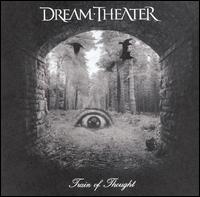
Dream Theater: Train of Thought (2003) – Dream Theater were damn good already when I got to know their music through the Awake album. After that failed 1997 experiment, they got really good on Metropolis and simply wrote and played better and better stuff until they got really scary on Train of Thought.
Not even two years after the massive Six Degrees of Inner Turbulence we are served with another collection of songs. And they're much harder than the last outing. This time, guitarist John Petrucci decided to leave all his inhibitions at home and just let it rip during each and every guitar solo. For those who do not appreciate the thrill and excitement of playing guitar really fast, it might come off as too much, but from one shredder to another, it hits very close to home.
As usual, DT serves their prodigous chops in seven monolithic songs where the final 25 minutes, the instrumental Stream of Consciousness and the closer In the Name of God, together constitute the most concentrated bone-crushing slab of music these guys have ever committed to disc.
Spotlight song: In the Name of God
Thanks to: Myself.
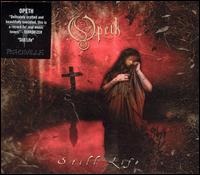
Opeth: Still Life (1999) – Opeth is a band that existed under the radar for me for many years. I kind of knew that they were from Sweden and that they played some form of metal, but for some reason I never checked them out until my friend Linus came to me raving about this new Swedish band that he had heard. We didn't get around to meeting until I made an impulse purchase of Still Life at a local record store one Saturday in April 2005. I was immediately floored.
With the risk of running into overly flowery prose, within five minutes, I was amazed how music could fit my particular taste so perfectly. Opeth is fun for the whole family. At the heart of the music, it's death metal with a wonderful melodic instinct. Even if they had settled for that, this would have been one of my favorite bands.
But Mikael Åkerfeldt and company do not stop there. Not only do they have the sense to inject their basic death metal sensibilities with an uncanny sense of melody and atmosphere, they have the guts to cut from the heaviest heavy parts, growling about death and torment, to a really vulnerable and intimate acoustic section with a clean jazz guitar solo.
Throughout basically any recent Opeth album, one thing can be taken for granted: the musicianship is top-notch. Special kudos have to be given to Martin Lopez' drumming and Mikael Åkerfeldt's combination of death growl and clean baritone singing.
Spotlight song: The Moor – A summation of Opeth in 11 minutes.
Thanks to: Linus—and welcome back to Nick's Musical Influence Club.
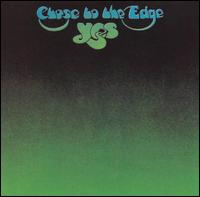
Yes: Close to the Edge (1972) – Yes always struck me as the sort of band that I should be into. The same thing also struck my friend Linus, who promptly spent a couple of years trying to get me to like them. In comparison with his successful six-month campaign to get me into metal back in 1989-90, this must have come off like a veritable marathon!
In my book, Yes are comparable to classical music. Their music takes a lot of effort to grasp and get into, and it's quite possible to spend a long time being simply overwhelmed, but as soon as you find that way in, it all falls into place and the amazing beauty and complexity of their music is laid bare for you to see.
It was a long time coming, but I finally realized what all the fuss was about. And now I kick myself for not getting to know Yes and Close to the Edge earlier. It is the perfect mix of beautiful, poetic lyrics, skillful songwriting and virtuoso playing. Probably the best thing that could be said about Edge is that I don't have the slightest clue what to write about it. I am tempted to simply stop here and let the music speak for itself, to let the reader immerse himself or herself in the roller-coaster of emotions and moods that are encountered during these three songs and 40 minutes.
Spotlight song: Close to the Edge
Thanks to: Linus.
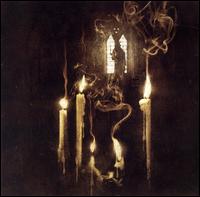
Opeth: Ghost Reveries (2005) – Ghost Reveries is a just about perfect album that carefully blends together all the styles that Opeth have been experimenting with since 1995. There's their signature melodic death metal with alternating growled and clean lyrics, there's the delicate acoustic interludes, and this time everything is topped with a bit of the 70s-style progressive rock sound that dominated the metal-free Damnation album. New full-time keyboard player Per Wiberg adds another dimension to Opeth's studio (as well as live) sound with his swirling Mellotron lines and organ stabs. Somehow this all fits together!
As a music enthusiast and Opeth fanatic, what I am most excited about is how everything has come together on this record: a logical evolution all the way from 1995's Orchid. And in contrast with other bands who appear on this list, who feel past their prime, it feels like Opeth have just entered theirs.
Without knowing much about the new drummer Martin Axenrot, I am very sad to see Martin Lopez go. He is one of the most capable and solid drummers I have come across in metal, a master of taste and style and the perfect fit for a band that plays such varied music as Opeth. When you hear him play, you go: "that's it, that's the only drum beat that will fit this riff".
Another thing that constantly amazes me about Opeth is how they never stick with a riff for too long, or not long enough. It is always perfect, and just about when you feel like a change, they throw in a variation or a counter-rhythm or whatever. I especially like that in spite of the distorted metal guitar tone, they are not afraid of playing comparatively (for distorted guitar) complex chord voicings, like minor major sevenths and minor added ninths. It adds color to the music without having to resort to distracting effects processing and it is a refreshing alternative to the E-string chugging of other bands.
Spotlight song: Atonement
Thanks to: Linus.
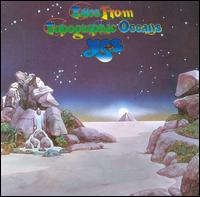
Yes: Tales from Topographic Oceans (1973) – At the time of this writing (early 2008), this is one of the most frequently played albums in the Andreasson household. I just can't seem to get enough of it. It is mandatory listening especially for the Friday evenings when my wife is at work and I'm sitting on the couch with the computer in my lap, working on my website or one of my writing projects.
It is not difficult to be daunted by the massiveness of this album: four tracks, but of such length that they can't even fit on one 80-minute CD. I listen to Tales for the same reason that I listen to Mahler whenever I am on a classical trip: the plain and simple challenge involved in digesting such a giant musical work and trying to make sense of it.
One of the words that are frequently encountered in discussions of this album is polarized. Either you love it or you hate it. I admit to being in the former category, but still I can't help but to point out some reservations. The high points of this album—The Revealing Science of God and The Remembering—are (mostly) on the same level as the very finest Yes has written, but at the same time, whereas Close to the Edge is a flawless album, Tales has some weak points, and where it's weak, it's also really weak. For the life of me, I cannot understand how an extremely skilled and tasteful guitar player like Steve Howe should find it necessary to sabotage The Ancient with that abrasive, out-of-tune steel guitar. Especially when the song ends so beautifully with the classical guitar piece.
But in the end, this is a monolithic piece of art that is well worth studying.
Spotlight song: The Revealing Science of God
Thanks to: Linus